
CIMRM Supplement - Twin Mithraea from Doliche, Commagene, Turkey
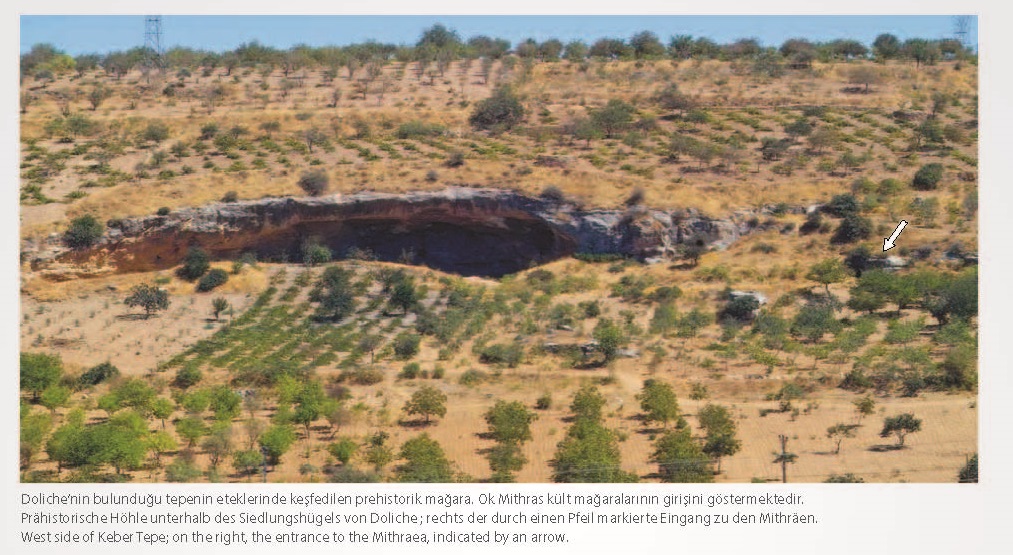


Mithraeum 1
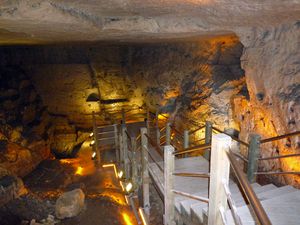
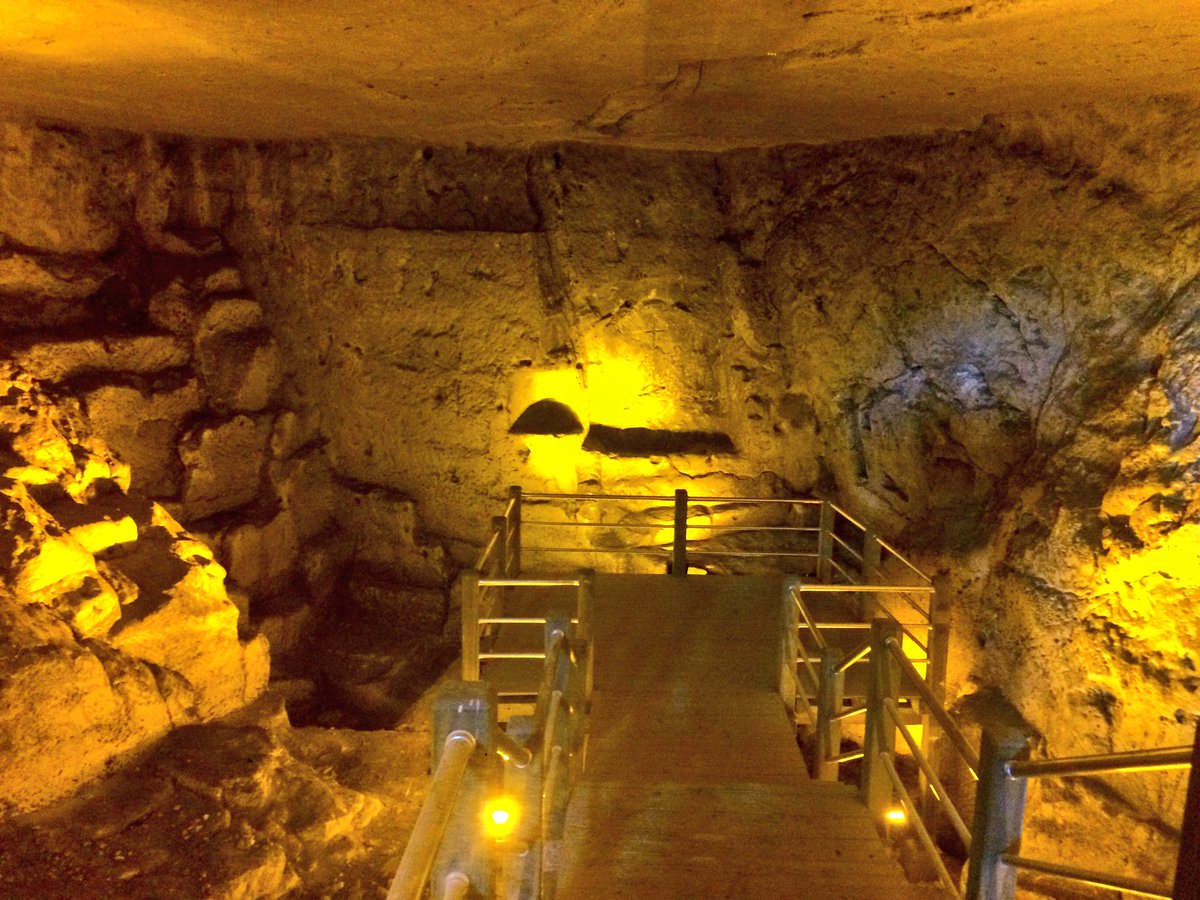

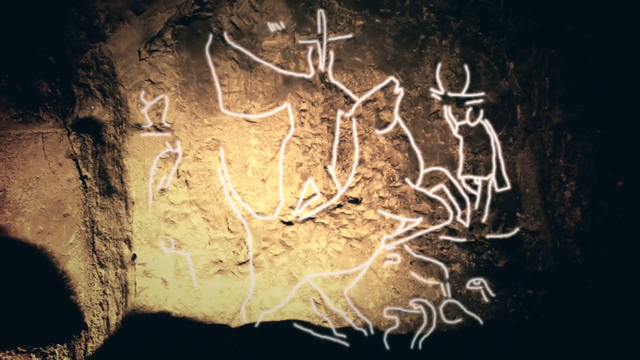
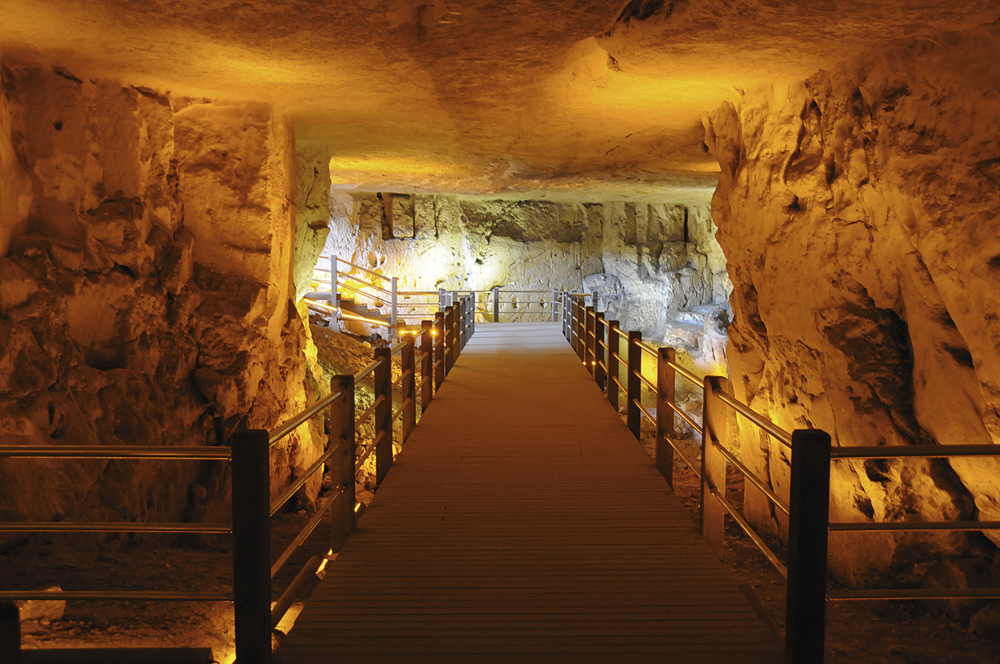
Mithraeum 2

Additional photos here.
Two Mithraea were discovered in caves at ancient Doliche. Various pulverised ceramics give a date of the 1st-3rd c. AD. There are coins of the time of Elagabalus (3rd c.).
The caves appear to have been worked as a quarry in an earlier period, perhaps attested by a coin of Antiochus IX of Commagene. When the Mithraea were constructed, a layer of lime and limestone was put in place to level the floor, up to 1m thick.
A narrow layer of fire damage above the floor-layer indicates the destruction of both Mithraea in the middle of the 3rd century AD. This probably occurs during the occupation of Doliche in 253 by the Sassanid king Shapur I. The destruction of the cult images cannot be dated, but is probably later, and probably by Christians. There are no indications of Christian use of the caves, other than the incised cross.
Mithraeum 1
In 1997 Mithraeum 1 was discovered in a limestone cave at Keber Tepe, under the hill on which Doliche was built. A series of caves exist along the western slope, under a rocky overhang, which were published in the 1950s. About 50m south-west of this is another cave. The opening was only 1.4m tall when discovered, and covered with vegetation.
On entering the cave, a long corridor some 2m wide descends towards a cave where an upright rock has obviously been worked. The distance to the ceiling is between 1.4 and 2m. It is not clear what the original height was, because of extensive rock-falls and silting up. There is a round shaft about 10m inside the entrance, about 1m in diameter, and going upwards. This was perhaps a ventilation shaft. The level of the walking area drops sharply. Behind a large boulder in the ceiling is a tabula ansata. The inscription is not readable unfortunately.
After this the cave opens into the cult chamber, an elongated rock hall of impressive dimensions, ca. 22 x 5-11m wide, and H ca. 6m.
On the wall opposite the entrance is the cult image carved out of the rock, and depicting the tauroctony. The niche (H ca. 2.1 m, W 1.80 m) is preceded by three ledges. A pool has been carved into the top step. Other pools and niches are in the walls, some evidently worked by tools, others left in the natural state.
The cult image has been largely destroyed by an attempt to chisel it off from above at an angle. A cross has been cut into the rock in the area where the head of Mithras was.
Mithras kneels with his left leg on the bull that is rearing up, he has stretched the right leg down. The upper body of the god is kept straight. His left arm is raised and passed behind the bull's head. His right arm is bent over his chest. Hand or dagger can no longer be recognized. From the clothing, clear outlines can only be seen from the coat that is blowing backwards. The bull rears up standing on its hind legs to the right. His forelegs are angled. In the area below the bull, further representations belonging to the iconography of these cult images can be identified: the scorpion reaching for the bull's testicles, the snake on the crater and the dog jumping up on the bull. Two other elaborations on the lower right could be depictions of a lion and a rooster. The torchbearers are on both sides of the bull killing scene: Cautes on the right, Cautopates on the left. Above the two torchbearers there is a short bridge with an oval design; likewise below the bull's tail. Above the torchbearers, it must have been the heads of the personified winds. If you stand directly in front of the cult image, you can still see the feet of a bird, probably the raven, to the left of the head of Mithra or the cross. The bull killing scene is completed by an arch. The pictorial representations in the gussets above the arch are very poorly preserved. Only vaguely the bust of Luna can be seen on the right and that of Sol on the left.
Mithraeum 2
In 1997 a cavity in the SE wall of the entrance area of the cave about 8m from the entrance was noted. In 1998 excavation revealed the entrance to a second cave, containing Mithraeum 2. This is even larger, ca. 32m x 18m. Average height is 5m from current floor level (in 2001). The hall contracts in the middle to about 5m wide. In the "rear" area, the cave widens towards the NW. There are severe rock-falls here, which may indicate a second entrance to the chamber.
The SE wall opposite the entrance is clearly worked for an area of 9.5m The cult image is in the middle, above several rock falls. The tauroctony scene (ca. H 1.7m, W, 2.4 m) has also been destroyed with a chisel. In the place where the god Mithras was originally represented, there is also a large, niche-shaped hole. As a result, the head of Cautopates and the back of the bull are also unrecognizable. Despite the destruction, the remaining outline of the bull, the torchbearer and individual figurative representations below the bull can still be identified. The bull rears up on its hind legs, standing high to the right. Below the bull, the outlines of a scorpion, a snake and a lion are still weakly recognizable on the crater. The rear part of a dog jumping up to the chest of the bull as well as another figurative representation at the bottom right in the image field (Aion?) Can still be traced. On both sides of the bull, the torchbearers are shown on rocky elevations: Cautopates on the left, Cautes on the right. The elaboration above the cautery is probably the head of one of the wind gods. The bull killing scene is completed by an arch. In the gussets above, Luna on the right and Sol on the left can be clearly recognized by the crescent moon and the ray crown.
In 2001 much of the floor of the caves remained buried.
From: Doliche.de:
General view of the first Mithraeum. The Doliche Mithraeums were discovered in 1997 below the ancient mound of Doliche. They were created in an abandoned quarry. Two cult reliefs reveal the well-known representation of Mithras killing the bull, despite the devastation. The existence of two adjacent Mithraea indicates the presence of large numbers of followers of Mithras in Doliche. ... Until the discovery of the Mithraea in 1997, there was only a 1m x 1m high access to Mithraeum 1. Mithraeum 2 was completely sealed. This was the result of centuries of erosion. From the slope above, earth and rubble slid down into the caves, and raised the floor level at the entrance by up to 6m. In antiquity the ground level around the entrance was lower, the cave system was more open, and had to be completed by walls outside the Mithraea."
From: Michael Blömer, Engelbert Winter, "Doliche. An ancient town at the crossroads of civilisations. A guide to the ancient city area and the sanctuary of Jupiter Dolichenus.", 2018. here.
In 1997 and 1998 two cult spaces for the Mysteries of Mithras were discovered in an underground quarry located underneath the ancient site of Doliche. Because of their exceptional size, both Mithraea give the impression of massive rock halls. The Various niches were used to place lucernae (little oil lamps) or small statues. The excavations of the Mithraea have provided important results concerning their date. So far it seems that the cave where the Mithraea are located was used from the I BCE until the III CE.
Despite the fierce destruction, it is possible to recognize in two reliefs the well-known representation of Mithras the bullslayer. The god is kneeling on the sacred bull to stab it in the neck. A scorpion, a snake and a dog, animals which often appear in the sort of representation can be made out with difficulty. The two torch bearers, Cautes and Cautopates, flank the scene which is enclosed above by an arch; the figures of the sun god Sol and moon goddess Luna appear above it. In this relief, the head of the god was smashed and replaced with a cross: a clear hint of the destruction of this cult place by the Christians.
From: Roger Beck, Beck on Mithraism, p.14:
Doliche (Commagene) Here are two Mithraea in a single natural cave system, each with a tauroctony cut into the rock [19] (preliminary report, Schütte-Maischatz and Winter (2000)). As at Perge, these Mithraea are especially significant because they are located in a region, Anatolia, where relatively few Mithraic monuments have been found - even fewer monuments of the developed Roman cult - and where anything discovered may impinge on the vexed question of origins and transmission. The implications of the Doliche Mithraea will be addressed in the Introduction to Part II. Suffice it to say here that the two tauroctonies, both with elements typical of reliefs in the provinces of the Rhine frontier (that is, the addition of a crater and a lion to the snake beneath the bull so as to form a compositional triad), prove that in the late second or early third centuries ce Doliche was home to Mithraism of the normal occidental type but with a particular affiliation to the cult on the Rhine frontier, the medium of transfer presumably being the military. Beyond that not inconsiderable addition to the dossier on Mithraism's extent, the phenomenon of two Mithraea in a single cave - a sort of Mithraic duplex - is a striking and so far unique discovery. It appears to bear out dramatically the lesson of the Virunum alba (above): if full, found a new parallel community (Gordon, 2001).
See Anke Schütte-Maischatz and Engelbert Winter, Doliche - Eine kommagenische Stadt und ihre Götter. Mithras und Iuppiter Dolichenus, 2004, p.79-127. 189-195. These date the two complexes to the 1st century A.D. 1
Coordinates: 37° 04' N, 37° 23' E / 37.067° N 37.383° E.2
Bibliography
There are a very large number of research publications. The Schütte-Maischatz (2008) appears to be the final one.
- J. Wagner (ed.), "Gottkönige am Euphrat. Neue Ausgrabungen und Forschungen in Kommagene", Sonderband Antike Welt, Mainz a.Rh, 2000
- E. Winter, "Mithraism and Christianity in Late Antiquity", in S. Mitchell and G. Greatrex (eds), Ethnicity and Culture in Late Antiquity, London, 2000, 173-82.
- Anke Schütte-Maischatz, Engelbert Winter, "Die Mithräen von Doliche. Überlegungen zu den ersten Kultstätten der Mithras-Mysterien in der Kommagene", Topoi 11 (2001), 149-173. Online here.
- A. Schütte-Maischatz and E. Winter, "Die Mithräen von Doliche. Überlegungen zu den ersten Kultstätten der Mithras-Mysterien in Kommagene", Topoi 11.1 (2001), 149-73. Online here.
- E. Winter, "Doliche in hellenistisch-römischer Zeit. Eine kommagenische Stadt zwischen Tradition und Innovation", in E. Schwertheim and E. Winter (eds), "Stadt und Stadtentwicklung in Kleinasien", Asia Minor Studien Bd. 50, Bonn, 2003, 51-67
- A. Schütte-Maischatz, "Götter und Kulte Kommagenes. Religionsgeographische Aspekte einer antiken Landschaft" in E. Schwertheim and E. Winter, Religion und Region. "Götter und Kulte aus dem östlichen Mittelmeerraum", Asia Minor Studien. Bd. 45, Bonn, 2003, 103-13
- A. Schütte-Maischatz and E. Winter, "Doliche - eine kommagenische Stadt und ihre Götter. Mithras und Jupiter Dolichenus", Asia Minor Studien Bd. 52, Bonn, 2004.
- R. Gordon, "Mithras in Doliche: issues of date and origin" , Journal of Roman Archaeology 20 (2007).
- A. Schütte-Maischatz and E. Winter, Doliche. Eine kommagenische Stadt und ihre Kulte: Mithras und Iupiter Dolichenus, Bonn, 2008. - This appears to be the final version.
| 1 | J. Mylonopoulos, Natur als Heiligtum - Natur im Heiligtum, in Archiv für Religionsgeschichte 10/2008, ed. Jan Assmann &c., De Gruyter, ISBN: 978-3-11-020288-5 (online), p.79: "135 Es handelt sich nicht um natürliche Höhlen, sondern um artifiziell zum Zwecke des Stein-abbaus entstandene Stollen, die zu einem späteren Zeitpunkt in Mithräen umgewandelt wurden. A. Schütte-Maischatz - E. Winter, Doliche - Eine kommagenische Stadt und ihre Götter. Mithras und Jupiter Dolichenus (2004) 79-127. 189-195 datieren die zwei Komplexe in das 1. Jh. v.Chr. In seinem Rezensionsbeitrag lehne R. Gordon, "Mithras in Doliche: issues of date and origin", Journal of Roman Archaeology 20 (2007) 602-610 diese Datietung komplett ab und vermutet stattdessen, dass die Mithräen erst im 3. Jh. n.Chr. entstanden sind. Die vorgelegten Grabungsbefunde offenbaren eine so stark gestörte Stratigraphie, dass weder für die frühe noch für die spate Datierung genügend Argumente vorhanden sind." |
| 2 | This information kindly supplied by John W. Brandt. |
| Tweet |

